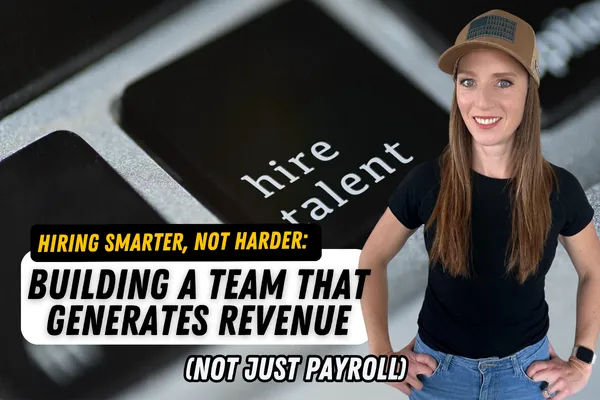
HIRING SMARTER, NOT HARDER: BUILDING A TEAM THAT GENERATES REVENUE (NOT JUST PAYROLL)
Hiring Smarter: Build a Revenue-Generating Construction Team
TABLE OF CONTENTS
WHY HIRING SMARTER MATTERS
A contractor once told me:
“Liz, I keep hiring helpers… but somehow my payroll goes up while my profit keeps shrinking.”
This problem is far more common than most owners admit.
Most contractors don’t hire with intention — they accumulate people. They bring on whoever shows up, simply hoping the workload gets lighter. Instead, they end up with a payroll bill that grows… while profit shrinks.
Here’s the truth most contractors never hear:
Your team should generate revenue — not just consume it.
In a healthy construction business, every role should produce or protect at least 2× its cost.
When that happens?
You get your time back
You stop firefighting
You finally evolve from Chief Everything Officer to CEO
This guide shows you how to hire smarter — not harder — using the same systems I install for $1–5M contractors inside the Contractor Operating System™.
WHY MOST CONTRACTORS HIRE WRONG
Most hiring mistakes happen before the interview — not during it.
1. Hiring Out of Desperation
Someone quits.
Jobs fall behind.
You panic-post an ad on Indeed.
A warm body applies… and you hire them.
This is the #1 cause of:
High turnover
Low performance
Endless owner frustration
Desperation hiring is expensive — in time, money, and morale.
2. No Clarity on Role Outcomes
Most contractors can describe tasks.
But ask them:
“What measurable outcomes does this role own?”
Silence.
When expectations aren’t crystal clear:
Accountability disappears
Performance drops
You end up micromanaging
Clarity is not optional — it is the foundation of a self-managing team.
3. Employees Become Overhead Instead of ROI
Owners often hire to “lighten the load.”
But if a hire does NOT:
Reduce your workload
Increase your revenue
Improve efficiency
…then you didn’t hire a team member — you hired overhead.
This is why so many owners work 60–70 hours per week despite having a full team. You’re surrounded by people… yet still doing everything.
THE REVENUE GENERATOR MINDSET
Here’s the mindset shift that changes everything:
Every role must directly or indirectly generate 2× its cost.
Examples:
A project manager should increase profitability and reduce overruns
A foreman should improve efficiency and reduce waste
An admin should free up your time so you can generate revenue
A VA should remove 10–15 hours/week off your plate
If someone costs $60,000/year, they must create at least $120,000/year in ROI.
This forces you to ask:
How will this role make the business money?
What KPIs prove this role is working?
What outcomes will they own?
Contractors who adopt this thinking no longer hire “helpers.”
They hire profit multipliers.
THE SMARTER HIRING FRAMEWORK (STEP-BY-STEP)
This is the exact framework I teach inside the Roundtable Mastermind.
STEP 1: Time Audit — Your Wasted Hours = Your New Hire’s Job
You can’t hire correctly without knowing what you should NOT be doing.
We track:
Time-draining tasks
Tasks only the owner should do
Tasks that could be delegated
Tasks that are costing revenue because YOU are doing them
If your time is worth $500/hr, you shouldn’t be doing $15/hr tasks.
The time audit always reveals the next correct hire.
STEP 2: The Role Detective Questionnaire
This eliminates guesswork by forcing clarity.
Ask yourself:
What does this role own?
What results must they deliver weekly?
How will I measure success?
What tasks must they STOP doing?
Does this role generate or protect revenue?
Most contractors think they need a PM.
But after the Role Detective process, they discover they need a foreman or VA first.
Role clarity = profit clarity.
STEP 3: Job Description + KPIs That Attract A-Players
A real job description includes:
Role summary
Specific outcomes
Top responsibilities
KPIs tied to revenue or time savings
Reporting rhythms
Vague job descriptions attract B- and C-players.
Clear ones repel the wrong candidates and attract high performers.
STEP 4: The 30-60-90 Day Onboarding Plan
Employees don’t fail because they're bad — they fail because their onboarding is bad.
A great onboarding plan includes:
First 30 days
Training
Shadowing
Learning systems
Understanding expectations
60 days
Taking over responsibilities
Demonstrating proficiency
Producing measurable output
90 days
Owning the role
Hitting KPIs
Generating ROI
Reducing the owner’s workload
This is how contractors in my program get new hires producing ROI in under 90 days.
STEP 5: Align Roles With Working Genius
Skill is not enough.
Working Genius (W, I, D, G, E, T) reveals:
Strengths
Bottlenecks
Natural energy
Friction points
Example:
One remodeler had a team full of “ideas” people (Invention/Discernment), but no Tenacity.
Result?
Punch lists dragged, jobs stalled, clients frustrated.
We hired one person with Tenacity + Enablement.
Within 60 days, the business transformed.
REAL-WORLD HIRING EXAMPLES
These are real outcomes from contractors using the system.
1. The $27/hr VA Who Saved 10 Hours/Week
This contractor was drowning in admin:
Emails
Scheduling
Estimates
Material orders
Change orders
Client communication
After hiring a VA:
Saved 10+ hours/week
Estimates went out faster
Errors dropped
Client communication improved
That’s 520 hours/year saved.
At $200/hr value:
→ $104,000 in reclaimed value from one hire.
2. Foreman Who Increased Revenue by $20k in 90 Days
The owner thought he needed a PM.
The Role Detective revealed he needed a foreman.
Result:
Increased field efficiency
Fewer delays
Better sub accountability
Owner freed from daily jobsite babysitting
→ $20,000 in new revenue in 90 days
→ Jobs finished faster with fewer callbacks
→ Owner got his evenings back
HOW TO KNOW IF YOU HIRED CORRECTLY
1. The 30-Day Check
You should see:
Less chaos
Better communication
Some workload coming off your plate
If not — that’s a red flag.
2. The 90-Day ROI Check
By Day 90, they should generate 2–3× their cost through:
Higher efficiency
Faster closeouts
Less rework
Better scheduling
Owner saving 10+ hours/week
Increased gross profit
If they aren’t producing ROI, the issue is usually clarity — not the person.
FINAL THOUGHTS
You don’t need more people.
You need the right people, doing the right things, in the right order, with the right systems.
Hiring is NOT about:
Filling seats
Cheap labor
“Helpers”
Putting out fires
Hiring IS about:
Increasing profit
Reducing chaos
Removing yourself as a bottleneck
Building a business that runs without you
When you hire smarter, you finally step into the CEO role — and your business begins to scale without sacrificing your sanity.
Imagine having a business that runs even when you’re not on the job site.
That’s what happens when you hire smart—not out of desperation.
If you're ready to:
✨ Step out of day-to-day operations
✨ Hire people who take ownership
✨ Build systems the whole team follows
✨ Reclaim your time
✨ Grow profit without growing chaos
Then your next step is simple:
👉 Join the Contractor Operating System and build the team that gives you freedom.
FAQ: Hiring Smarter, Not Harder
1. How do I know who to hire first?
2. How can I tell if someone will actually be a revenue generator?
3. What if I don’t have time to hire or train someone?
4. What roles should directly make money vs. support revenue?
5. How long should it take for a new hire to produce ROI?
6. I’ve been burned before. How do I avoid a bad hire this time?
7. How do I interview for the right traits—not just skills?
8. What if I can’t afford a full-time hire?
9. Do systems matter more than hiring?
10. How do I create clear KPIs for each role?
11. What’s one sign I hired the wrong person?
12. How do I know when I’m truly hiring smart—not hiring more chaos?
1. How do I know who to hire first?
Start by identifying where your time is being wasted.
Your time audit will reveal exactly which tasks are costing you the most money—and which role should take them over.
Most contractors jump ahead and hire a PM, estimator, or sales rep when what they truly need is a VA or foreman first.
Your wasted hours = your next hire’s job description.
2. How can I tell if someone will actually be a revenue generator?
Use this simple question:
“Will this role directly or indirectly generate at least 2× their cost?”
Revenue generators:
Reduce job delays
Increase efficiency
Improve communication
Free up owner time
Increase close rates
Finish jobs faster
Reduce rework and mistakes
If their presence doesn’t increase profit or decrease your workload, they’re not a revenue generator.
3. What if I don’t have time to hire or train someone?
That’s exactly why you need to hire.
If you’re too busy to hire, you’re trapped in the 80% of low-value work that keeps you stuck.
Hiring the right person creates capacity so you can get back into the 20% that actually grows your business.
4. What roles should directly make money vs. support revenue?
Direct Revenue Roles:
Project Manager
Foreman
Estimator
Sales/BD
Lead carpenter (in premium services)
Indirect Revenue Roles:
Office admin
VA
Bookkeeper
Coordinator
Scheduler
Indirect roles should free enough of your time that you can generate far more revenue than their cost.
5. How long should it take for a new hire to produce ROI?
30 days: Reduced workload, improved communication
60 days: Taking ownership of core responsibilities
90 days: Producing 2–3× their cost in revenue, productivity, or efficiency
If you don't see ROI by Day 90, there's a clarity or training issue—not a hiring issue.
6. I’ve been burned before. How do I avoid a bad hire this time?
Three things prevent bad hires:
Clarity (role, outcomes, KPIs)
Structured onboarding (30-60-90 days)
Working Genius alignment
Most bad hires were actually victims of unclear expectations and poor onboarding—not bad employees.
7. How do I interview for the right traits—not just skills?
Ask scenario-based questions:
“Tell me about a time you finished a job when everyone else dropped the ball.”
“What systems do you rely on to stay accountable?”
“How do you handle incomplete information on a job?”
You’re testing:
Ownership
Communication
Tenacity
Problem solving
Accountability mindset
The right mindset beats skill every time.
8. What if I can’t afford a full-time hire?
Then start with a part-time VA, fractional role, or trial period.
A good VA will free up 10–15 hours/week for less than $30/hr—often returning $50,000–$100,000+ in reclaimed value.
You can scale into full-time roles as the ROI compounds.
9. Do systems matter more than hiring?
Systems alone won’t save you.
People alone won’t save you.
It’s the combination of systems + people + accountability that removes you as the bottleneck.
A players still need structure. B players become A players because of structure.
10. How do I create clear KPIs for each role?
Ask:
“If this employee only did these 1–2 things exceptionally well, would they earn their keep?”
Examples:
PM → Jobs delivered on time/on budget
Foreman → Reduce wasted labor hours by 10%
Admin → Turnaround time for communication under 24 hrs
VA → Save owner 10+ hrs/week with documented tasks
KPIs must tie directly to revenue, efficiency, or owner freedom.
11. What’s one sign I hired the wrong person?
If by week 4 you feel no difference in your stress level, workload, or job performance—you hired wrong or onboarded wrong.
By week 12, they should be a multiplier, not a manager-dependent task rabbit.
12. How do I know when I’m truly hiring smart—not hiring more chaos?
Hiring is “smart” when:
Your workload decreases
Profit margins increase
Jobs run smoother
Communication improves
You’re not answering 47 questions/day
The business runs when you’re not there
You start acting like a CEO, not a firefighter
When your team generates revenue—not drama—you’ve hired smart.

